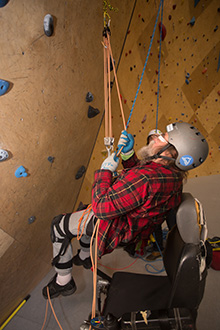Adaptive climbing is reaching new heights thanks to specialty equipment and accessible sites across the country
At first, Art Torrey didn’t really have any interest in adaptive rock climbing. But when a climbing gym opened next door to the makerspace where he works in Somerville, Mass., he decided it was worth a shot, if only to test the gym’s accessibility.
After trying out a traditional adaptive ascender bar and harness, Torrey desired a more intimate experience with the climbing wall.

“An ascender bar, is as far as I’m concerned, like about as boring as you can get. It’s basically how many pullups can you do? You don’t really interact with the wall. There’s no problem-solving,” says the 60-year-old, who sustained a T5 spinal-cord injury, American Spinal Injury Association classification B, in March 2010 as the result of surgery to repair his spine after a tree-cutting accident.
Torrey has taken a slightly different approach to climbing. For a few years, he tinkered with a tentacle climbing system — similar to the one adaptive climber Sean O’Neill uses — and customized it to fit his specific needs and climbing style.
With his unique pulley system, Torrey began lead climbing, which means the first climber to go up is not protected by a rope from above him or her, as is the case with top roping.
He earned his indoor lead climbing card about two and a half years ago, and last fall, he conducted his first outdoor lead climb at the Shawangunks State Park, aka The Gunks, in New York.
The pulley system Torrey designed and built includes a cleat, similar to the ones found on a boat, so he can tie off his rope and have his hands free.
“The standard campus climbing that most paraplegics do is you’re hauling yourself up on the rocks with your arm strength, and you’re doing the top rope as progress capture. So, you’re really doing the top rope all the time and you have to have that top rope there because that’s what’s keeping you from sliding down. Whereas, I’m basically substituting the tentacle end for my hands and feet, so I’m just hanging off the wall with my hands free, so I can place gear, I can clip into [quick]draws, I can do anything else that’s related to making the climb that I need to.”

Other essential equipment includes kneepads, gloves, a helmet and clothing that offers sun protection and a good range of motion.
He says The Gunks is his favorite outdoor climb because of its easy wheelchair access via a carriage road that runs along the base of the crag. Indoors, he’s evolving his technique to be able to conquer more challenging routes, including one called The Tongue – 50 vertical feet with last 20 feet curving into a horizontal overhang.
He continues to make improvements to his gear, as well. He says his next goal is to make the whole system smaller, so he doesn’t have to carry as much weight.
“When I haul myself up, I’ve gotta make a gear placement as high up as I can reach, and the farther I can haul myself up, the higher I can make the next gear placement,” he says. “If I can haul myself up farther, that gives me either more reach for the next gear placement or more choices on where I make the next one.”
He says having total trust in your belayer, the person who controls the climber’s safety rope, goes a long way toward calming any fears.
“It’s part of the game. It’s part of the whole challenge of a climb is, yes, there is a certain amount of risk involved,” he says. “All of your gear is designed to be redundant in terms of there would have to be two or three things that would have to fail in a row before you would actually take a hard fall.”
Torrey says the best place for someone to start learning adaptive climbing is in a gym with experienced adaptive climbing instructors. There, a new climber can learn his or her limits, learn what safety equipment to use and can feel safe pushing the limits a little bit to make progress.
“It gets rid of a lot of the extra barriers and it saves a lot of learning some of the things like gear placement,” he says.